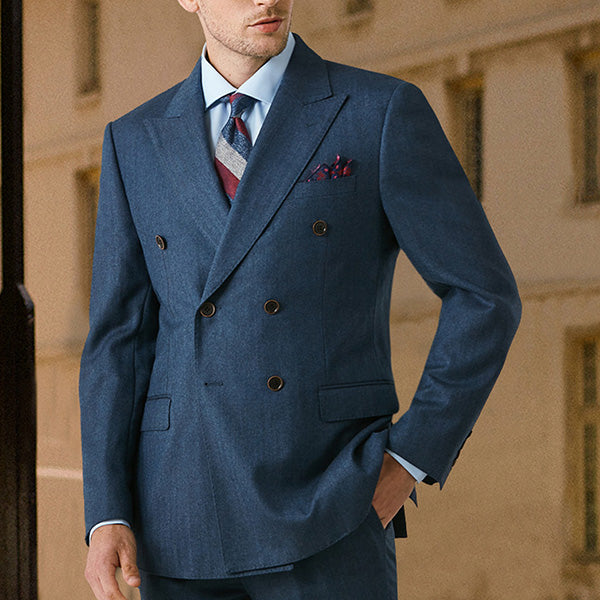Tuxedo vs. Suit: Understanding the Differences
We often get asked about the difference between a tuxedo and a suit. While we’ve touched on this topic in previous blog posts, we’ve never written a full, dedicated guide to answer this question. So today, we’re going to take a deep dive into the physical differences between the two, the less tangible distinctions, and the exceptions to the rule.
Physical Differences
The most obvious and defining physical difference between a tuxedo and a suit is the presence of satin. Traditionally, tuxedos feature satin accents—on the lapels, buttons, pocket trim, and even along the leg of the trousers. In contrast, suits do not incorporate any satin. They tend to have fabric-covered buttons or plastic buttons that match the color of the suit, known as "self-covered" buttons. While some modern tuxedos have reduced the use of satin, usually just featuring a thin satin trim along the lapels and a small satin stripe down the pant leg, the hallmark of a tuxedo is the satin detailing.
Suits, on the other hand, are all about consistency in fabric. A suit jacket is usually made from the same material throughout, and while the design can vary (from structured to soft, single-breasted to double-breasted), there’s nothing like the glossy accents that give tuxedos their formal flair.
When it comes to accessories, the differences become more apparent when talking about traditional black-tie standards. For many modern tuxedo occasions—think proms or weddings—the lines between tuxedo and suit accessories are often blurred. However, traditionally, tuxedos are only worn with a bow tie and either a cummerbund or waistcoat (low stance vests). Suits, on the other hand, are generally paired with long ties and high stance vests, which are reserved for more casual formalwear.

Exceptions to the Rule
Though satin is generally a defining feature of tuxedos, there are some exceptions. One notable variation is the Tropical Black Tie, or the classic white dinner jacket. This tuxedo style doesn’t incorporate any satin but is still considered formal enough to be classified as black tie attire. The jacket itself is typically white, with a self-shawl lapel, a one-button front, and self-flap pockets. It’s a rare but historically significant style, often worn in warmer climates or summer events where a black tuxedo might feel too heavy.
Another satin-less tuxedo option is available in certain modern tuxedo lines, such as the Allure Men Tuxedo collection by Jean Yves. This collection includes tuxedos in various colors like tan and slate blue, with the same cut and construction as their black or gray counterparts, but without any satin detailing. These styles are incredibly popular for daytime weddings and less traditional tuxedo functions, offering a fresh take on the classic tuxedo silhouette.
The Message Behind the Look
Beyond the physical differences, there is a subtle, yet significant, difference in the message that a tuxedo sends compared to a suit. For many people, wearing a suit is a regular part of life, whether for work, events, or social gatherings. It’s normal to see people in suits at the grocery store, at business meetings, or even at weddings. And while a suit may be a rare wardrobe item for some, it’s still something that doesn’t carry the same level of occasion-specific symbolism as a tuxedo.
This is where the true distinction lies. A tuxedo isn’t just something you wear to “dress up” or look nice; it’s something you wear to commemorate a moment, to signal that the occasion is so special that only this particular outfit will do. It’s about showing respect for the event, and the people involved, by wearing something that you wouldn't wear any other time.
When you wear a tuxedo, you’re not just trying to look your best. You’re sending a message that this is a unique, memorable event. It says, “This is where I want to be, and I’m honoring this moment by wearing something extraordinary.” A suit simply doesn’t carry that same weight of meaning. It’s perfectly suitable for a variety of events, but it doesn’t hold the same ceremonial significance as a tuxedo does.
Why It Matters
The reason a tuxedo is reserved for high-formality events is that it has become the gold standard of elegance and respect. Whether it’s a black-tie wedding, a gala, or a celebratory dinner, a tuxedo tells the world that you understand the importance of the occasion. It’s a statement of occasion, of distinction, and of commitment to looking your best.
In contrast, suits are more versatile. While still formal, they aren’t always associated with a particular level of respect or significance. It’s rare for someone to wear a suit to a truly special event and have it stand out as the ultimate symbol of formality. On the other hand, when you see someone in a tuxedo, it immediately signals that the event is special, and the person wearing it knows that.

Conclusion: When to Choose a Tuxedo or a Suit?
Choosing between a tuxedo and a suit ultimately comes down to the occasion. A tuxedo is your go-to choice for black-tie events, formal galas, or any event that calls for a truly distinguished, ceremonial look. It’s not just about dressing up—it’s about marking a moment in time with an outfit that signifies respect and appreciation for the occasion.
A suit, on the other hand, is ideal for business functions, semi-formal events, or weddings where the atmosphere isn’t quite as strict. It’s versatile, stylish, and appropriate for a wide range of occasions, but it lacks the formality and weight of a tuxedo.
So, when in doubt, consider the event. If the dress code calls for black tie, you know what to do. If it’s a less formal event, a well-tailored suit will have you looking sharp and ready to impress. Both choices are great—just make sure you choose the right one for the right occasion!





